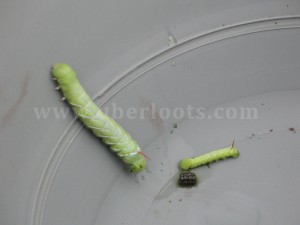Posted by Aimee | Posted in Insects | Posted on 11-05-2009
Tags: brandywine tomato, Insects, manduca quinquemaculata, Pest Control, tobacco hornworm, tobacco worm, Tomato, tomato hornworm, tomato hornworm caterpillar
This evening I was out in my garden, after a long day at work, forcing myself to get the herbs transplanted that I had wanted to get moved this last weekend and had not. When I saw what at first I thought must be a tiny tomato starting out of the corner of my eye with a bright green quarter inch globe mostly hidden through the thick foliage of my brandywine tomato. I couldn’t help myself I reached out as I have a habit of doing and touched it.
This momentous error on my part was followed by an extremely embarrassing high pitched squeak of terror when I realized that it was no tomato at all but a living critter. After I had a second to recover from the realization that I was touching bare handed a massive, scary looking caterpillar with a fierce looking orange horn. As I watched it undulated itself slowly to another branch, it kept going and going it was a good 3-4 inches long. I had never seen a caterpillar this big and he looked ferocious, that’s for sure! At first I assumed my uninvited guest was the dread tomato hornworm caterpillar I had read about, but he is actually the tobacco hornworm caterpillar Manduca sexta.
The two are very similar in appearance. The easiest way to tell them apart is by the horn color. On the tomato hornworm (Manduca quinquemaculata) the horn will be a dark black/blue and on the tobacco caterpillar it is a bright orange/red. Also the tomato caterpillar has white V shaped markings down its sides and the tobacco worm has white slashes.
So now that we have learned the identity of our culprit (of which I found three though I have pictures of only two) a little about their eating habits and life cycle ensues. They will consume any plant in the nightshade family. Some of the plants in that family are weeds, like the nightshade, however most of them are foodstuff crops for us humans like potatoes, tomatoes, eggplant, and peppers. They will feast on the inner, shaded foliage during the heat of the day working their way out ward when the temperature is cooler. Detection is possible before we find our plants over run by voracious vermin though. From late April and all the way through late July (as best as I can tell for the Houston Area) we can check the undersides on the leaves of these plants for small pearl shaped and tinted eggs, the eggs can also be a pale green. Rub them off with a q-tip dipped in rubbing alcohol if you find them. If you do find them as worms hand picking seems to be our best option. Especially since they are so large, just make sure you check from all angles. After they feast on our plants for 3-4 weeks and reach 3-4 inches they will leave the host plant and bury themselves into the ground and cocoon. The cocoon is brownish red with a “pitcher handle” or weird looking stick protruding from it. These can be cut in half with scissors if found, I am not sure if tossing them into a bucket of soap water like the caterpillars will work or not. If these cocoons hatch they become the moth version of this pest often called hummingbird moths or hawk moths. They will mate and lay eggs soon after hatching and are capable of traveling long distances. You would be most likely to see them at your porch light during the late evening or at night.
A few more interesting facts about hornworm caterpillars is that you can sometimes locate them via the droppings “frass” they leave behind or below them while feeding. Apparently I scared the “frass” out of the one in my bucket if you look at the picture *ewww* If you see these signature little markers look above them to locate your plant devourer. Also in the picture you can note what the much younger version of the caterpillar looks like. They are very similar in appearance but the younger one does not have markings as distinct along its sides but that name inspiring horn is still there. The hornworm has a natural enemy too, the parasitic wasps (braconid wasps) often target caterpillars to lay their eggs in. Though you will not know if this has occurred until you see the tell tale white cocoons on the worms back. The cocoons look kind of like grains of rice stuck to the worm. If you happen to find a hornworm that has been parasitized you may want to take it with a leaf put well down into a glass jar in your garden so that the caterpillar can no longer do any more damage to your garden and the wasps will hatch, kill the host and hunt other hornworms from your garden and kill them and other pests as well.


